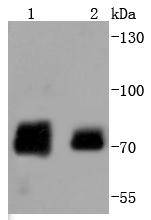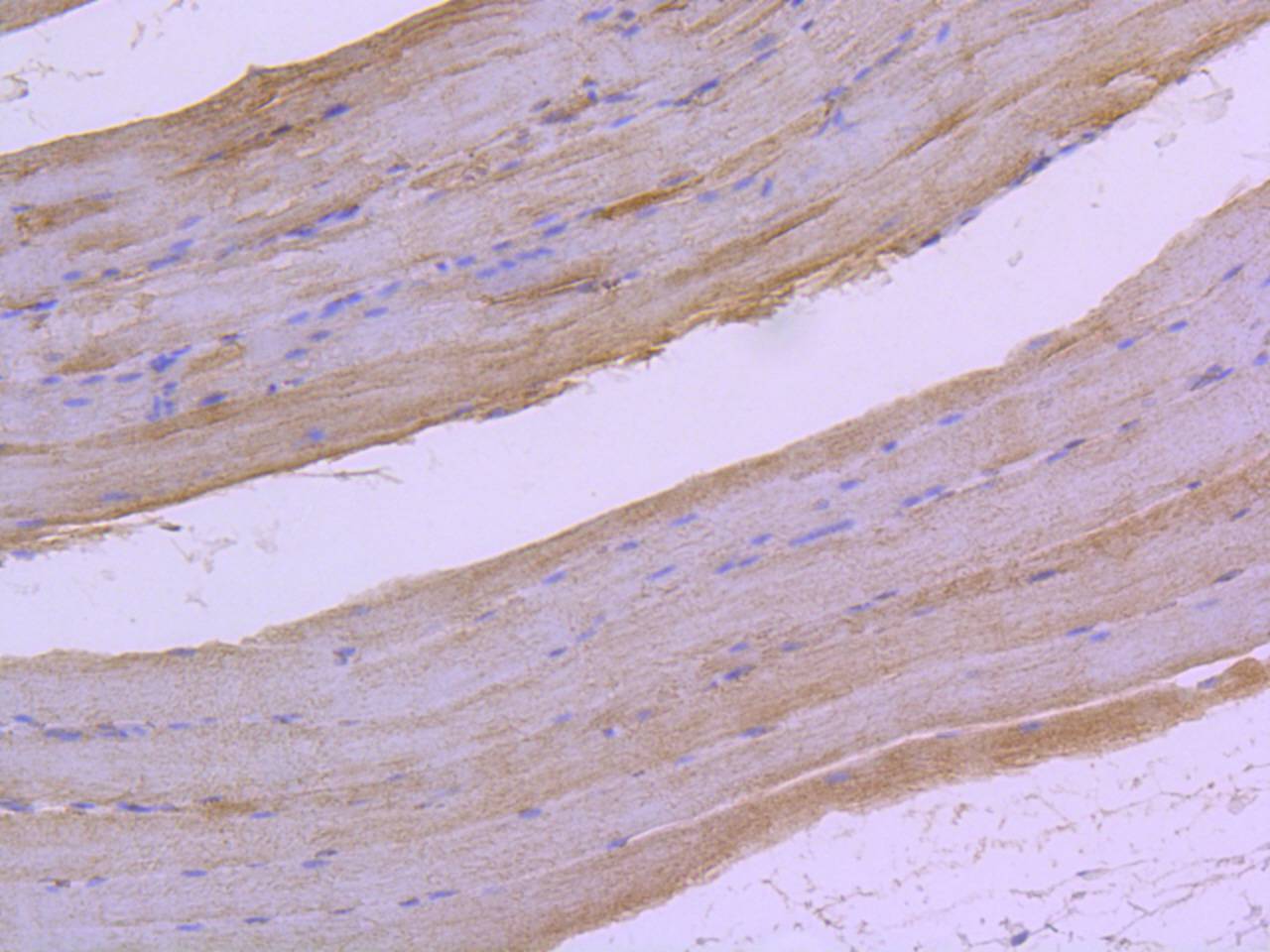Product Name :
Raf1 (Phospho-S259) polyclonal antibody Background :
Raf-1 is a ubiquitously expressed cytoplasmic protein with intrinsic serine/threonine kinase activity. Raf-1, or c-Raf, is the cellular homolog of v-Raf, the product of the transforming gene of the 3611 strain of murine sarcoma virus. The unregulated kinase activity of the v-Raf protein is associated with cellular transformation and mitogenesis. Raf-1 is normally suppressed by its regulatory N-terminal domain. Raf-1 is activated in response to a variety of tyrosine kinase receptors as well as in response to pp60v-Src expression. Specifically, Raf-1 is phosphorylated in the catalytic domain at Ser 338 and, to a lesser extent, Ser 339. This phosphorylation requires the co-activation of PI 3-kinase and the Ras signaling pathway. Raf-1 is also phosphorylated on Tyr 340 and 341, which induces the phosphorylation of MEK. Phosphorylation of Ser 621 is essential for the catalytic activity of Raf-1 and downregulation by c-AMP-dependent protein kinase A (PKA). PKA also phosphorylates Raf-1 on Ser 43 and Ser 259. PKA phosphorylation of Ser 259 inhibits Raf-1 and decreases the phosphorylation necessary for Raf-1 activation at Ser 338. Product :
Rabbit IgG, 1mg/ml in PBS with 0.02% sodium azide, 50% glycerol, pH7.2 Storage&Stability :
Store at +4°C after thawing. Aliquot store at -20°C or -80°C. Avoid repeated freeze / thaw cycles. Specificity :
Raf1 (Phospho-S259) polyclonal antibody detects endogenous levels of Raf1 protein only when phosphorylated at S259. Immunogen :
Synthetic phospho-peptide corresponding to residues surrounding Ser259 of human Raf1 Conjugate :
Unconjugated Modification :
Phosphorylation
Raf1 (Phospho-S259) polyclonal antibody Background :
Raf-1 is a ubiquitously expressed cytoplasmic protein with intrinsic serine/threonine kinase activity. Raf-1, or c-Raf, is the cellular homolog of v-Raf, the product of the transforming gene of the 3611 strain of murine sarcoma virus. The unregulated kinase activity of the v-Raf protein is associated with cellular transformation and mitogenesis. Raf-1 is normally suppressed by its regulatory N-terminal domain. Raf-1 is activated in response to a variety of tyrosine kinase receptors as well as in response to pp60v-Src expression. Specifically, Raf-1 is phosphorylated in the catalytic domain at Ser 338 and, to a lesser extent, Ser 339. This phosphorylation requires the co-activation of PI 3-kinase and the Ras signaling pathway. Raf-1 is also phosphorylated on Tyr 340 and 341, which induces the phosphorylation of MEK. Phosphorylation of Ser 621 is essential for the catalytic activity of Raf-1 and downregulation by c-AMP-dependent protein kinase A (PKA). PKA also phosphorylates Raf-1 on Ser 43 and Ser 259. PKA phosphorylation of Ser 259 inhibits Raf-1 and decreases the phosphorylation necessary for Raf-1 activation at Ser 338. Product :
Rabbit IgG, 1mg/ml in PBS with 0.02% sodium azide, 50% glycerol, pH7.2 Storage&Stability :
Store at +4°C after thawing. Aliquot store at -20°C or -80°C. Avoid repeated freeze / thaw cycles. Specificity :
Raf1 (Phospho-S259) polyclonal antibody detects endogenous levels of Raf1 protein only when phosphorylated at S259. Immunogen :
Synthetic phospho-peptide corresponding to residues surrounding Ser259 of human Raf1 Conjugate :
Unconjugated Modification :
Phosphorylation
-
 Western blot analysis of Phospho-Raf1(S259) on different lysates using anti-Phospho-Raf1(S259) antibody at 1/1,000 dilution. Positive control: Lane 1: Human skeletal muscle Lane 2: Hela
Western blot analysis of Phospho-Raf1(S259) on different lysates using anti-Phospho-Raf1(S259) antibody at 1/1,000 dilution. Positive control: Lane 1: Human skeletal muscle Lane 2: Hela -
 Immunohistochemical analysis of paraffin-embedded rat skeletal muscle tissue using anti-Phospho-Raf1(S259) antibody. Counter stained with hematoxylin.
Immunohistochemical analysis of paraffin-embedded rat skeletal muscle tissue using anti-Phospho-Raf1(S259) antibody. Counter stained with hematoxylin.
Bioworld Biotech only provide peptides for our antibodies and do not provide additional peptide customization services.
Price/Size :
USD 368/1mg/vial
Tips:
For phospho antibody, we provide phospho peptide(0.5mg) and non-phospho peptide(0.5mg).Describe :
Blocking peptides are peptides that bind specifically to the target antibody and block antibody binding. These peptide usually contains the epitope recognized by the antibody. Antibodies bound to the blocking peptide no longer bind to the epitope on the target protein. This mechanism is useful when non-specific binding is an issue, for example, in Western blotting (WB) and Immunohistochemistry (IHC). By comparing the staining from the blocked antibody versus the antibody alone, one can see which staining is specific; Specific binding will be absent from the western blot or IHC performed with the neutralized antibody.Formula:
Synthetic peptide was lyophilized with 100% acetonitrile and is supplied as a powder. Reconstitute with 0.1 ml DI water for a final concentration of 10 mg/ml.The purity is >90%,tested by HPLC and MS.
Storage:
The freeze-dried powder is more stable. For short time at 2-8°C. For long term storage store at -20°C.
Note :
This product is for research use only (RUO only). Not for use in diagnostic or therapeutic procedures.
 Raf1 (Phospho-S259) polyclonal antibody
Raf1 (Phospho-S259) polyclonal antibody  Datasheet
Datasheet COA
COA MSDS
MSDS SHIP
SHIP